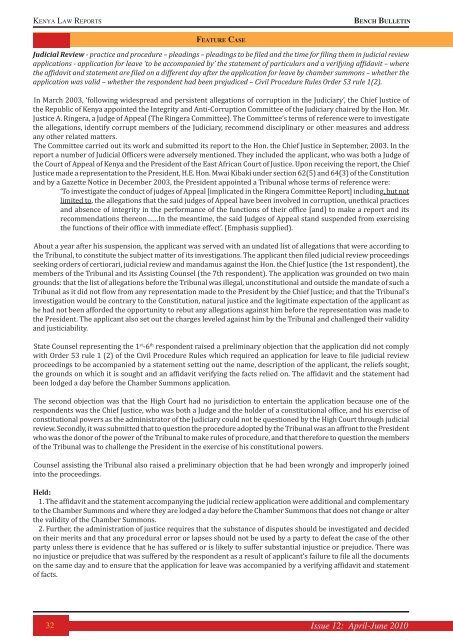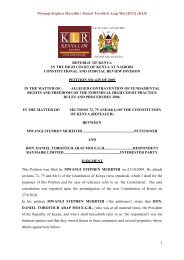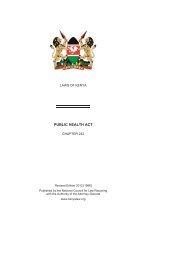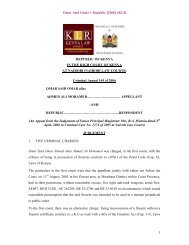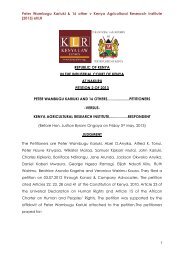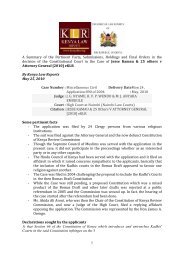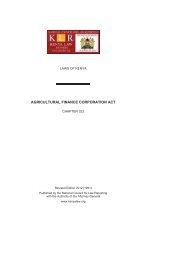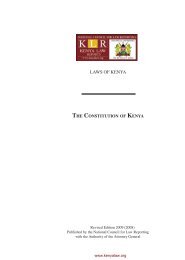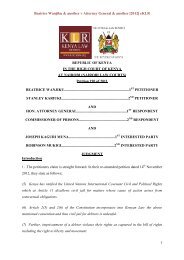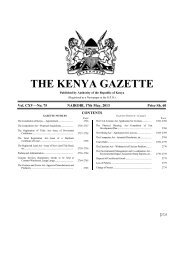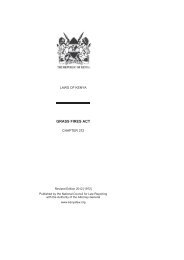Bench Bulletin - Issue 12 - Kenya Law Reports
Bench Bulletin - Issue 12 - Kenya Law Reports
Bench Bulletin - Issue 12 - Kenya Law Reports
You also want an ePaper? Increase the reach of your titles
YUMPU automatically turns print PDFs into web optimized ePapers that Google loves.
KENYA LAW REPORTS<br />
BENCH BULLETIN<br />
FEATURE CASE<br />
Judicial Review - practice and procedure – pleadings – pleadings to be filed and the time for filing them in judicial review<br />
applications - application for leave ‘to be accompanied by’ the statement of particulars and a verifying affidavit – where<br />
the affidavit and statement are filed on a different day after the application for leave by chamber summons – whether the<br />
application was valid – whether the respondent had been prejudiced – Civil Procedure Rules Order 53 rule 1(2).<br />
In March 2003, ‘following widespread and persistent allegations of corruption in the Judiciary’, the Chief Justice of<br />
the Republic of <strong>Kenya</strong> appointed the Integrity and Anti-Corruption Committee of the Judiciary chaired by the Hon. Mr.<br />
Justice A. Ringera, a Judge of Appeal (The Ringera Committee). The Committee’s terms of reference were to investigate<br />
the allegations, identify corrupt members of the Judiciary, recommend disciplinary or other measures and address<br />
any other related matters.<br />
The Committee carried out its work and submitted its report to the Hon. the Chief Justice in September, 2003. In the<br />
report a number of Judicial Officers were adversely mentioned. They included the applicant, who was both a Judge of<br />
the Court of Appeal of <strong>Kenya</strong> and the President of the East African Court of Justice. Upon receiving the report, the Chief<br />
Justice made a representation to the President, H.E. Hon. Mwai Kibaki under section 62(5) and 64(3) of the Constitution<br />
and by a Gazette Notice in December 2003, the President appointed a Tribunal whose terms of reference were:<br />
‘To investigate the conduct of judges of Appeal [implicated in the Ringera Committee Report] including, but not<br />
limited to, the allegations that the said judges of Appeal have been involved in corruption, unethical practices<br />
and absence of integrity in the performance of the functions of their office [and] to make a report and its<br />
recommendations thereon……In the meantime, the said Judges of Appeal stand suspended from exercising<br />
the functions of their office with immediate effect’. (Emphasis supplied).<br />
About a year after his suspension, the applicant was served with an undated list of allegations that were according to<br />
the Tribunal, to constitute the subject matter of its investigations. The applicant then filed judicial review proceedings<br />
seeking orders of certiorari, judicial review and mandamus against the Hon. the Chief Justice (the 1st respondent), the<br />
members of the Tribunal and its Assisting Counsel (the 7th respondent). The application was grounded on two main<br />
grounds: that the list of allegations before the Tribunal was illegal, unconstitutional and outside the mandate of such a<br />
Tribunal as it did not flow from any representation made to the President by the Chief Justice; and that the Tribunal’s<br />
investigation would be contrary to the Constitution, natural justice and the legitimate expectation of the applicant as<br />
he had not been afforded the opportunity to rebut any allegations against him before the representation was made to<br />
the President. The applicant also set out the charges leveled against him by the Tribunal and challenged their validity<br />
and justiciability.<br />
State Counsel representing the 1 st -6 th respondent raised a preliminary objection that the application did not comply<br />
with Order 53 rule 1 (2) of the Civil Procedure Rules which required an application for leave to file judicial review<br />
proceedings to be accompanied by a statement setting out the name, description of the applicant, the reliefs sought,<br />
the grounds on which it is sought and an affidavit verifying the facts relied on. The affidavit and the statement had<br />
been lodged a day before the Chamber Summons application.<br />
The second objection was that the High Court had no jurisdiction to entertain the application because one of the<br />
respondents was the Chief Justice, who was both a Judge and the holder of a constitutional office, and his exercise of<br />
constitutional powers as the administrator of the Judiciary could not be questioned by the High Court through judicial<br />
review. Secondly, it was submitted that to question the procedure adopted by the Tribunal was an affront to the President<br />
who was the donor of the power of the Tribunal to make rules of procedure, and that therefore to question the members<br />
of the Tribunal was to challenge the President in the exercise of his constitutional powers.<br />
Counsel assisting the Tribunal also raised a preliminary objection that he had been wrongly and improperly joined<br />
into the proceedings.<br />
Held:<br />
1. The affidavit and the statement accompanying the judicial reciew application were additional and complementary<br />
to the Chamber Summons and where they are lodged a day before the Chamber Summons that does not change or alter<br />
the validity of the Chamber Summons.<br />
2. Further, the administration of justice requires that the substance of disputes should be investigated and decided<br />
on their merits and that any procedural error or lapses should not be used by a party to defeat the case of the other<br />
party unless there is evidence that he has suffered or is likely to suffer substantial injustice or prejudice. There was<br />
no injustice or prejudice that was suffered by the respondent as a result of applicant’s failure to file all the documents<br />
on the same day and to ensure that the application for leave was accompanied by a verifying affidavit and statement<br />
of facts.<br />
32<br />
<strong>Issue</strong> <strong>12</strong>: April-June 2010


